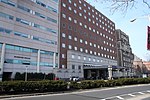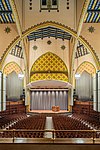University of Pennsylvania Campus Historic District

The University of Pennsylvania Campus Historic District is a historic district on the campus of the University of Pennsylvania, in Philadelphia, Pennsylvania, USA. The university relocated from Center City to West Philadelphia in the 1870s, and its oldest buildings date from that period. The Historic District was added to the National Register of Historic Places on December 28, 1978. In 1978, the Historic District comprised 28 contributing properties over 117 acres (0.47 km2). One of them, the Lea Laboratory of Hygiene ("Smith Labs"), was demolished in 1995. Three contributing properties within the Historic District — College Hall, Furness Library, and Richards Medical Research Laboratories — are separately listed on the NRHP. St. Anthony Hall House is adjacent to the Historic District, and was listed on the NRHP in 2005.
Excerpt from the Wikipedia article University of Pennsylvania Campus Historic District (License: CC BY-SA 3.0, Authors, Images).University of Pennsylvania Campus Historic District
Civic Center Boulevard, Philadelphia
Geographical coordinates (GPS) Address Phone number Website Nearby Places Show on map
Geographical coordinates (GPS)
| Latitude | Longitude |
|---|---|
| N 39.949166666667 ° | E -75.194444444444 ° |
Address
Children's Hospital of Philadelphia
Civic Center Boulevard 3401
19104 Philadelphia
Pennsylvania, United States
Open on Google Maps








